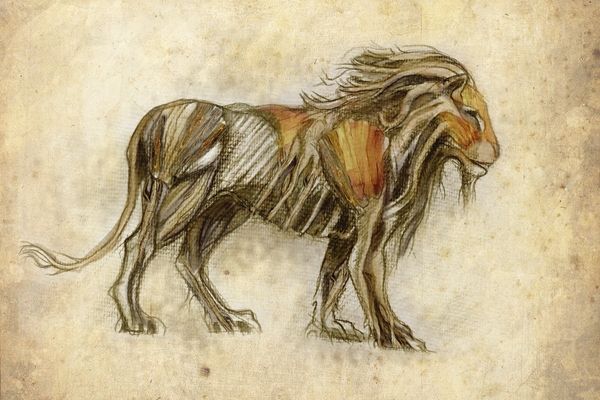Lloyd Evans talks to the young, dynamic and much-in-demand Tom Scutt about the challenges of bringing to life Narnia and its inhabitants
Barky? What does he mean, ‘barky’? We’re talking about Aslan and he says he’s aiming for ‘barky’. ‘Barky like a dog or barky like a tree?’ ‘Like a tree,’ says Tom Scutt, designer of The Lion, the Witch and the Wardrobe, which opens on 8 May in Kensington Gardens.
‘What I often do with Rupert [Goold, the director] is to imagine setting the whole show in one location. In this case, the wardrobe. So you trace the wood of the wardrobe back to a tree and Aslan has a link with a tree, something honest and true and majestic. That felt right. And in Narnia the witch is an extreme form of nature, freezing ice and burning fire, which would impede the metaphorical growth of a tree. So the lion needs a “barky” quality, leaves and roots, and not just fur.’
I meet Scutt in a hotel overlooking Kensington Gardens. Through the windows we can just glimpse the venue, a huge, double-pointed marquee that squats on the grass like two foaming swirls of Mr Whippy ice cream. With only ten days before the first preview there are many difficulties ‘still in flux’, as Scutt says. Who will play Aslan? No one’s been confirmed. Will his voice be live or prerecorded? ‘We’re exploring the options.’ How does Aslan work in the space? They haven’t yet got him inside the marquee. All they know for sure is that Aslan’s jaw won’t waggle up and down like a ventriloquist’s dummy. ‘That would debunk the majesty of the character. And right now my focus is on nailing the movement.’
They’ve built an Aslan model — ten-foot long and six-foot high— that a trio of puppeteers will operate, two inside the body and one outside. ‘There are comparisons with War Horse, obviously,’ says Scutt. ‘But the mobility of a cat is one of the hardest things to achieve. The spine is very fluid, the hocks are difficult. Not like a horse at all. And a lion has a particular presence, stealthy, very quiet, very calming too, but also quite intimidating. Once we get that, then the character’s voice will emerge through those movements.’
He seems very relaxed about managing a team of 70 fitters, hatters, wiggers and costume-makers. ‘Relaxed? Philosophical maybe,’ he says. ‘But there’s only so far you can go with being stressed out because suddenly you’re looking at an actress dressed as a squirrel. The book constantly disarms you.’
And was the Aslan puppet the hardest challenge? Instead of discussing other features of the design, he replies with a conceptual overview of the entire production. ‘The hardest challenge is the complexity of the world, of Narnia, and the conflicting desire to honour the story and the roots of the book, and the visuals associated with that, and at the same time to tell the story afresh for a new generation. We’re using a huge spectrum of disciplines here, musical theatre, opera, circus, dance, puppetry, acting, video projection and illusion. And you have to be sure these disciplines aren’t just flashy for the sake of it but remain essential to the telling of the story.’ He continues in this vein. ‘We’re aware of the fan base and how close people hold this book to their hearts. Because we do as well. That’s the pressure: to honour the expectations of the audience and to deliver something people can see, and believe in, as being Narnian. And have a damn good time too!’
This practised oration reminds me that the best theatre people are always great blarneyers. At just 28, Scutt has mastered the pitter-patter early. His sales pitch is impossible to discredit but equally hard to swallow fully. It’s a cover story, really, a form of nervous camouflage which deflects attention from the obvious fact that the creative people haven’t a clue how the show will look, or feel, or work, until they’ve finished creating it. But they need to assuage the backers, and their money-angst, so they employ this special jargon to generate an air of complete confidence in the journey before they’ve taken the first step. And it works. It spins millions from the hands of twitchy investors. It’s as much a form of magic as anything in Narnia.
Clearly Scutt’s not short of self-confidence so has he considered directing? ‘I often think I could see myself directing. And then I see them do it and I think, “Oh, no.” And the more I design, the more I realise it’s OK to want to direct but just to be a designer. And vice versa. Rupert is a very good designer. And designers often turn to directing and it’s bloody awful. It’s a very dangerous trap to fall into.’
Not a definite yes, then. But he’s very clear how lucky he is to have landed such a huge job so soon after graduating. He left the Welsh School of Music and Drama in 2006. The following year he was ‘totally fortunate to reach the final of the Linbury Prize, which is one of the very, very few theatre design awards’. He was assigned to a group under Rupert Goold. ‘And I was fortunate enough to win that group, too.’ And things took off. He’s booked up for the next 12 months working with Scottish Opera and the RSC. This autumn he’ll design Jonathan Pryce’s Lear at the Almeida. And at Christmas he returns to the Lyric, Hammersmith for ‘my regular gig. I’ve done the panto for the last four years and it feels like an end of term blow-out. You can put all the stuff on stage which you censor yourself from doing throughout the rest of the year. You think, that’s awful: put it on stage. It’s very therapeutic. I recommend it for everybody.’
And where next for Narnia? He replies with great exactitude. ‘The show is on a similar scale to Peter Pan, which toured America. It opened in 2009 and closed last year. Narnia is capable of touring and is built with that in mind.’ But first it has to prove itself by selling eight shows a week for 14 weeks. ‘Nine shows a week,’ he corrects me. ‘The seats cost £40, average, and if every seat is sold that makes a box-office take of £8,765,000.’ ‘And what’s the total budget?’ I ask. ‘Half that?’ ‘I have absolutely no idea.’ Which I don’t entirely believe. But a spot of selective ignorance won’t do him any harm.
And I’m beginning to understand his uncertainty about becoming a director. That’s not his destiny. He’s going to be a producer. In all but name, he is already.







Comments